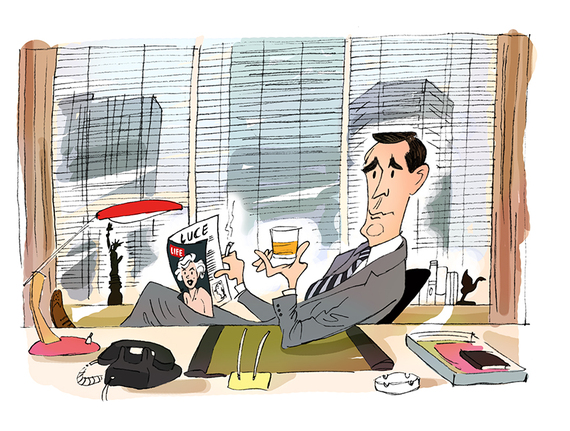Drawing by Eliane Gerrits
I have come from far away, but now I'm finally on the Olympus of American journalism: the famous, high-modernist Time-Life building in midtown Manhattan. Here the magazines that I grew up with -- Life, Time, People -- were published. They determined my image of America and the world. It is no coincidence that this beautiful skyscraper is used for the exterior shots on Mad Men, so aptly does it bring to life the 1960s.
But guess what? The company Time Inc., publisher of these magazines, can no longer afford this prestigious address. The day after my visit, it will spin off from Time Warner to become an independent company. The good news? They will be on their own once again. The bad news? They are broke. So the company will be leaving next year to move downtown. I feel a little as if I have finally arrived at my favorite five-star restaurant and the chef tells me that they will be closing.
I recently joined a few hundred journalists on this day to attend the annual Luce Awards. These prizes, honoring the company's best journalistic work in words, photos, and videos, are named after Henry Luce, the legendary founder of Time. He saw early in the last century that America needed a weekly news summary in a national magazine. The concept took off like a rocket. For decades, magazines like Time, Life, People, Fortune and Sports Illustrated were the face of America. To be on the cover of Time was a news-making event, especially when the editors chose the Man or Woman of the Year. People more or less invented the modern concept of celebrity, from Liz Taylor to Princess Diana, Michael Jackson to Kim Kardashian.
But no longer. The '90 magazines owned by Time Inc. are suffering from shrinking profits. Like other "dead-tree" journalists, they swim against the tsunami of digital media. It is significant that one of the most affecting Luce Awards goes to a winner in the category of multimedia. The magazine Sports Illustrated for Kids did an article about a 14-year-old boy who coached wrestling at Sandy Hook Elementary School, where so many children were killed by a deranged man. The accompanying video was a hit on YouTube and has been an inspiration to many.
After the Awards end, I wander nostalgically through the deserted corridors of the building. Framed on the walls are the iconic photos from Life and the other magazines. It's as though I am walking through the history of America. The salute of little John-John at the coffin of his father. The first man on the Moon. Marilyn Monroe with sultry eyes and disheveled dress. A wounded Vietnam soldier hanging between his two comrades. Muhammad Ali, then known as Cassius Clay, raising his arms over the defeated Sonny Liston, sprawled on the canvas. After all these years, I get goosebumps again. Closer to history than these cover photos you could not come, at least if you grew up in a small town in Holland. But the future is uncertain for this illustrious company, orphaned in a digital wilderness.
I look around the corner and see a half-empty office with a distinctive decor. There is Don Draper, slumped in his chair, a whiskey in hand and a cigarette in the mouth. He leafs through the latest Life. Marilyn is on the cover.
Yes, the '60s are over. But the legend lasts.
